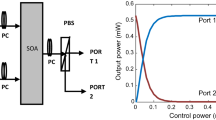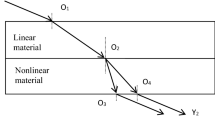Abstract
Frequency-encoded optical processors based on multivalued logic (MVL) will play a significant role in future all-optical networks. In this work, basic optical logic gates are designed using a modified trinary system, exploiting the switching action of semiconductor optical amplifiers (SOAs) based on the principle of the nonlinear rotation of the polarization of a probe beam in the presence of a pump beam. A control unit capable of performing OR, AND, and XOR logic operations depending on the frequency of the control signal is then developed. Finally, a trinary logic unit is designed to execute 27 different logic operations. The feasibility of these proposals is confirmed by simulation results. In this approach, each trinary bit, i.e., “trit,” is represented by a unique frequency, which in turn helps to address the noise margin problem that arises in intensity-encoded MVL systems. This scheme can therefore play an important role in errorless optical computing and processing.






























Similar content being viewed by others
References
Hillerkuss, D., Schmogrow, R., Schellinger, T., Jordan, M., Winter, M., Huber, G., Vallaitis, T., Bonk, R., Kleinow, P., Frey, F.: 26 Tbits—1 Line-rate super-channel transmission utilizing all-optical fast Fourier transform processing. Nat. Photon. 5, 364–371 (2011)
Willner, A.E., Khaleghi, S., Chitgarha, M.R., Yilmaz, O.F.: All-optical signal processing. J. Lightwave Technol. 32, 660–680 (2014)
Singh, K., Kaur, G.: Interferometric architectures based all-optical logic design methods and their implementations. Opt. Laser Technol. 69, 122–132 (2015)
Willner, A.E., Khaleghi, S., Chitgarha, M.R., Yilmaz, O.F.: Optics and photonics: key enabling technologies. In: Proceedings of the IEEE, vol. 100, Special Centennial Issue, pp. 1604–1643, 13 May (2012)
Ghosh, A.K., Basuray, A.: Binary to modified trinary number system conversion and vice versa for optical super computing. Nat. Comput. 9, 917–934 (2010)
Datta, A.K., Basuray, A., Mukhopadhyay, S.: Arithmetic operations in optical computations using a modified trinary number system. Opt. Lett. 14, 426–428 (1989)
Patel, V., Gurumurthy, K.S.: Arithmetic operation in multi-valued logic. Int. J. VLSICS 1(1), 21–32 (2010)
Smith, K.C.: The prospects for multi-valued logic: a technology and applications view. IEEE Trans. Comput. 30(9), 619–634 (1981)
Bhattacharya, A., Ghosh, A.K., Maity, G.K.: Implementation of quadruple valued flip-flops using CMOS and spatial light modulator-based Savart plate. Int. J. Nanoparticles 10(1–2), 141–164 (2018)
Mandal, S., Mandal, D., Mandal, M.K., Garai, S.K.: Design of optical quaternary adder and subtractor using polarization switching. J. Opt. 48(3), 332–350 (2018)
Ghosh, A.K., Bhattacharya, A., Raul, M., Basuray, A.: Trinary arithmetic and logic unit (TALU) using Savart plate and spatial light modulator (SLM) suitable for optical computation in multivalued logic. Opt. Laser Technol. 44, 1583–1592 (2012)
Band, N.C., Trivedi, A.U.: Review on high performance quaternary arithmetic an logic unit in standard CMOS. Int. J. Recent Innov. Trends Comput. Commun. 2(12), 4176–4179 (2014)
Hurst, S.L.: Multiple-valued logic—its status and its future. IEEE Trans. Comput. C-30(12), 1160–1179 (1984)
Shim, S., Park, S., Hong, S.: Design of advanced multiple-valued D-FF using Neuron-MOS. Int. J. Comput. Sci. Netw. Secur. 6(9B), 118–123 (2006)
Chattopadhyay, T.: All-optical symmetric ternary logic gate. Opt. Laser Techol. 42, 1014–1021 (2010)
Iftekharuddin, K.M., Awwal, A.A.S., Chowdhury, A.M.: Characterization of intensity-coded multi-valued logic circuit implementation. Opt. Eng. 38(3), 508–513 (1999)
Awwal, A.A.S., Karim, M.A., Cherri, A.K.: Polarization-encoded optical shadow-casting scheme: design of multi-output trinary combinational logic units. Appl. Opt. 26(22), 4814–4818 (1987)
Taraphdar, C., Chattopadhyay, T., Roy, J.N.: Designing of an all-optical scheme for single input ternary logical operations. Optik 122, 33–36 (2011)
Chattopadhyay, T.: Design of optical reconfigurable balanced ternary arithmetic logic unit using MEMS based design. Opt. Commun. 356, 123–135 (2015)
Garai, S.K.: Novel method of designing all optical frequency-encoded Fredkin and Toffoli logic gates using semiconductor optical amplifiers. IET Optoelectron. 5(6), 247–254 (2011)
Garai, S.K.: A scheme of developing frequency encoded tristate optical logic operations using semiconductor optical amplifier. J. Mod. Opt. 57(6), 419–428 (2010)
Mandal, S., Mandal, D., Mandal, M.K., Garai, S.K.: A scheme of developing all-optical frequency encoded ternary half adder using polarization switch. In: The International Conference on Fiber Optics and Photonics 2016, OSA, 4–8 December, 2016, IIT Kanpur, India (2016). https://doi.org/10.1364/photonics.2016.th3a.34
Kai, S., Ping, Y.: The symmetric MSD encoder for one-step adder of ternary optical computer. Opt. Commun. 372, 221–228 (2016)
Dorren, H.J.S., Lenstra, D., Liu, Y., Hill, M.T., Khoe, G.: Nonlinear polarization rotation in semiconductor optical amplifiers: theory and application to all-optical flip-flop memories. IEEE J. Quantum Electron. 39(1), 141–148 (2003)
Dutta, N.K., Wang, Q.: Semiconductor Optical Amplifiers. World Scientific, Singapore (2006)
Mandal, D., Mandal, S., Garai, S.K.: A new approach of developing all-optical two bit binary data multiplier. Opt. Laser Technol. 64, 292–301 (2014)
Mandal, S., Mandal, D., Garai, S.K.: An all-optical method of developing data communication system with error detection circuit. Opt. Fibre Technol. 20(2), 120–129 (2014)
Mandal, S., Mandal, D., Mandal, M.K., Garai, S.K.: Design of frequency-encoded data-based optical master-slave-JK flip-flop using polarization switch. Opt. Eng. 56(6), 066105 (2017)
Yongjun, W., Xinyu, L., Qinghua, T., Lina, W., Xiangjun, X.: All-optical clocked flip-flops and random access memory cells using the nonlinear polarization rotation effect of low-polarization-dependent semiconductor optical amplifiers. Opt. Commun. 410, 846–854 (2018)
Chen, X., Huo, L., Zhao, Z., Zhuang, L., Lou, C.: Study on 100-Gb/s reconfigurable all-optical logic gates using a single semiconductor optical amplifier. Opt. Express 24(26), 30245–30253 (2016)
Zhang, L., Kang, I., Bhardwaj, A., Sauer, N., Cabot, S., Jaques, J., Nielson, D.T.: Reduced recovery time semiconductor optical amplifier using p-type-doped multiple quantum wells. IEEE Photon. Technol. Lett. 18(22), 2323–2325 (2006)
Girardin, F., Guekos, G., Houbavlis, A.: Gain recovery of bulk semiconductor optical amplifiers. IEEE Photon. Technol. Lett. 10(6), 784–786 (1998)
Manning, R.J., Davies, D.A.O.: Three-wavelength device for all-optical signal processing. Opt. Lett. 19(12), 889–891 (1994)
Sugawara, M., Akiyama, T., Hatori, N., Nakata, Y., Ebe, H., Ishikawa, H.: Quantum-dot semiconductor optical amplifiers for high-bit-rate signal processing up to 160 Gb/s and a new scheme of 3R regenerators. Meas. Sci. Technol. 13(11), 1683–1691 (2002)
Tajima, K.: All-Optical switch with switch-off time unrestricted by carrier lifetime. Jpn. J. Appl. Phys. 32(2), L1746–L1749 (1993)
Leuthold, J., Marom, D.M., Cabot, S., Jaques, J., Ryf, R., Giles, C.R.: All-optical wavelength conversion using a pulse reformatting optical filter. IEEE J. Lightwave Technol. 22(01), 186–192 (2004)
Wang, J., Marculescu, A., Li, J., Vorreau, P., Tzadok, S., Ezra, S.B., Tsadka, S., Freude, W., Leuthold, J.: Pattern effect removal technique for semiconductor-optical-amplifier-based wavelength conversion. IEEE Photon. Technol. Lett. 19(24), 1955–1957 (2007)
Yang, X., Weng, Q., Hu, W.: High speed all optical switches based on cascaded SOAs. In: Garai, S.K. (ed.) Selected Topics on Optical Amplifiers in Present Scenario, pp. 25–46. InTech, London (2012). ISBN: 978-953-51-0391-2.
Garai, S.K.: All-optical quaternary logic gates—an extension of binary logic gates. Opt. Laser Technol. 67, 125–136 (2015)
Author information
Authors and Affiliations
Corresponding author
Additional information
Publisher's Note
Springer Nature remains neutral with regard to jurisdictional claims in published maps and institutional affiliations.
Appendix
Appendix
From Eq. (6),
So, \(\partial \varphi^{\text{TE}} \left( {z,t} \right) = - \frac{1}{{2v_{\rm g}^{\text{TE}} }}\alpha^{\text{TE}} \varGamma^{\text{TE}} g^{\text{TE}} \left( {z,t} \right)\partial z\).
Integrating both sides yields
Since the phase variation takes place only along the Z-direction, the partial derivative reduces to the total derivative:
where L is the length of the SOA and \(C_{1}\) is a constant depending upon the initial phase of the mode. Here, we consider that the gain remains constant throughout the length of the SOA.
Now, from Eq. (7),
So, \(\partial \varphi^{\text{TM}} \left( {z,t} \right) = - \frac{1}{{2v_{\rm g}^{\text{TM}} }}\alpha^{\text{TM}} \varGamma^{\text{TM}} g^{\text{TM}} \left( {z,t} \right)\partial z\).
Integrating both sides yields
Since phase variation takes place only along the Z-direction, the partial derivative reduces to the total derivative:
Here we consider that the gain remains constant throughout the length of the SOA.
where \(\Delta \varPhi\) and \(\varphi_{0}\) are the phase difference between the two modes at the output of the SOA and the initial phase difference between the two modes at the input of the SOA, respectively.
From Eq. (11),
So, \(\frac{{\partial P^{\text{TE}} \left( {z,t} \right)}}{{P^{\text{TE}} }} = \left[ {\varGamma^{\text{TE}} g^{\text{TE}} \left( {z,t} \right) - \alpha_{\text{int}}^{\text{TE}} } \right]\frac{1}{{v_{\rm g}^{\text{TE}} }}\partial z\).
Now, integrating both sides yields
Here also, the variation takes place only along the Z-direction, thus the partial derivative reduces to the total derivative:
From Eq. (12),
Integrating both sides yields
Rights and permissions
About this article
Cite this article
Mandal, S., Mandal, D., Mandal, M.K. et al. A scheme for the development of a trinary logic unit (TLU) using polarization-based optical switches. J Comput Electron 18, 584–618 (2019). https://doi.org/10.1007/s10825-019-01310-w
Published:
Issue Date:
DOI: https://doi.org/10.1007/s10825-019-01310-w




